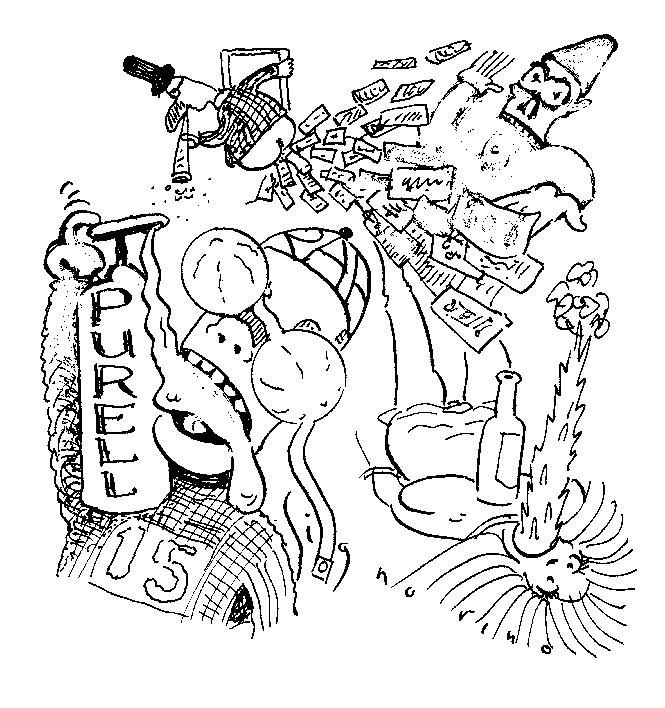
- Slug Signorino
My mother always asked us to wash our hands after touching money whenever possible. But is money really so out-and-out filthy that you risk serious illness every time you hand over cash at a drive-thru and then eat your burger? And: Do hundred-dollar bills really have measurable amounts of cocaine on them? —Bruce, Castro Valley, Calif.
Get ready for a deluge of I-told-you-so e-mail from vindicated mothers everywhere—in Bangladesh, for instance, where a 2006 study found that about 1 in 11 paper banknotes tested were contaminated with E. coli or similar bacteria. This isn't to say that Bangladeshis are literally wiping their butts with money (practically speaking, that's more likely to happen on Wall Street), but rather that bacteria are everywhere, including on currency. And unlike public toilets, twenties don't get hosed down every so often.
Lest you think Bangladesh particularlyunhygienic, 103 different fungal colonies were found on 60 randomly selected Egyptian banknotes—some of which were producing toxins. Some Philippine currency notes carried the cysts and ova of intestinal parasites, and were subsequently eliminated from use. Topping the list of diseased and potentially hazardous currency is Nigeria, where 90 percent of paper money is a home for bacteria. (Nigerian bills that were retired after heavy circulation proved to be so contaminated they were deemed a risk to treasury workers' lung function.)
American money might be slightly cleaner. A 2002 study in Ohio that collected and cultured 68 one-dollar bills produced a total of 93 bacterial samples; while 88 of these could pose a threat to people with compromised immune systems, five would be considered dangerous even to the healthy. For context, a similar experiment in Kentucky in 1972 turned up 26 of the scarier bacteria after swabbing 50 low-denomination bills, a rate more than seven times higher—evidence that in some limited ways American life may have become less disgusting over the last 40 years.
And yes, roughly 4 out of 5 American bills bear cocaine residue—but only because the powder is so fine that one patient-zero bill in an ATM can easily and quickly spread it to thousands. Don't get too excited, though: These amounts are so small that no one's getting high off the U.S. Mint's supply.
Pretty much everything has germs on it, and most of them won't kill you. Gas-pump handles, kitchen sinks, your date's mouth—you name it, it's probably coated with invisible bugs. Furthermore, we couldn't find any specific studies that tied illness incidence to handling money. If you're really paranoid, I suppose you could stick to coins, whose copper content seems to suppress their bacteria load. On the other hand, this will limit your cash purchases to gumballs, and may lead to even more awkwardness than usual when visiting strip clubs. Your mom probably warned you against those, too, but we'll keep our noses out it.
Palms of Purell
I am curious about the use of antibacterial hand gels that are commonly used to disinfect hands. Does excessive use of this substance (say, 40-plus times a day) somehow increase the risk of developing resistant bacteria, much in the same way as prescription of antibiotics has? —Felix
Heh. One of my little researchers used to deride Purell users as germ wussies. It took one trip to Thailand, three hand-sanitizer-less days and many, many trips to the bathroom before she saw the light. That said, worrying about Purell resistance suggests some possible apples/oranges confusion on your part.
Antibiotics work by disabling certain specific functions of a bacterial cell. For example, penicillin weakens cell walls. Occasionally some rogue bacillus will have some genetic variant rendering its walls penicillin-proof. Usually, your immune system can handle one or two of these guys. But when you take antibiotics needlessly, or incompletely, or off schedule, you may wind up wiping out the nonresistant bacteria and thus selectively breeding the resistant ones, which can then become the main source of infection. A recent example is every college student's nightmare: a drug-resistant strain of gonorrhea.
Alcoholic hand sanitizers, on the other hand, kill germs by first dissolving their lipid-based outer membranes and then dehydrating the proteins inside. Since nearly all bacteria have lipid membranes, 10-second submersion in alcohol can destroy all sorts of deadly and otherwise unpleasant bugs, from E. coli to staph. (The exceptions are bacterial spores like anthrax, which are basically the cockroaches of the bacterial world: They've got extremely thick outer coats and can survive extreme temperatures, chemical damage, and probably nuclear warfare if it came down to it.) For most bacteria, alcohol does such sweeping damage that becoming resistant to it would require a monumental structural leap—it would be like humans developing the ability to breathe without oxygen. It's not evolutionarily impossible, I guess, but so far the survival rate is zero.
So why don't we cure tuberculosis with alcohol? You try soaking your lungs in 190-proof ethanol—not only would you die, but they might burst into flame. Cool, perhaps, but ultimately ineffective.
Send questions to Cecil viaStraightDope.comor write him c/o Chicago Reader, 350 N. Orleans, Chicago 60654.